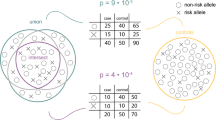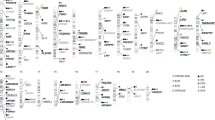Abstract
Genetic factors have been implicated in stroke risk, but few replicated associations have been reported. We conducted a genome-wide association study (GWAS) for ischemic stroke and its subtypes in 3,548 affected individuals and 5,972 controls, all of European ancestry. Replication of potential signals was performed in 5,859 affected individuals and 6,281 controls. We replicated previous associations for cardioembolic stroke near PITX2 and ZFHX3 and for large vessel stroke at a 9p21 locus. We identified a new association for large vessel stroke within HDAC9 (encoding histone deacetylase 9) on chromosome 7p21.1 (including further replication in an additional 735 affected individuals and 28,583 controls) (rs11984041; combined P = 1.87 × 10−11; odds ratio (OR) = 1.42, 95% confidence interval (CI) = 1.28–1.57). All four loci exhibited evidence for heterogeneity of effect across the stroke subtypes, with some and possibly all affecting risk for only one subtype. This suggests distinct genetic architectures for different stroke subtypes.
This is a preview of subscription content, access via your institution
Access options
Subscribe to this journal
Receive 12 print issues and online access
$209.00 per year
only $17.42 per issue
Buy this article
- Purchase on Springer Link
- Instant access to full article PDF
Prices may be subject to local taxes which are calculated during checkout




Similar content being viewed by others
References
Department of Health. Reducing Brain Damage: Faster Access to Better Stroke Care (National Audit Office, London, 2005).
Sacco, R.L. et al. Infarcts of undetermined cause: the NINCDS Stroke Data Bank. Ann. Neurol. 25, 382–390 (1989).
Dichgans, M. Genetics of ischaemic stroke. Lancet Neurol. 6, 149–161 (2007).
Jerrard-Dunne, P., Cloud, G., Hassan, A. & Markus, H.S. Evaluating the genetic component of ischemic stroke subtypes: a family history study. Stroke 34, 1364–1369 (2003).
Gretarsdottir, S. et al. Risk variants for atrial fibrillation on chromosome 4q25 associate with ischemic stroke. Ann. Neurol. 64, 402–409 (2008).
Lemmens, R. et al. The association of the 4q25 susceptibility variant for atrial fibrillation with stroke is limited to stroke of cardioembolic etiology. Stroke 41, 1850–1857 (2010).
Gschwendtner, A. et al. Sequence variants on chromosome 9p21.3 confer risk for atherosclerotic stroke. Ann. Neurol. 65, 531–539 (2009).
Markus, H.S. Genetics studies in ischaemic stroke. Transl. Stroke Res. 1, 238–245 (2010).
Adams, H.P. Jr. et al. Classification of subtype of acute ischemic stroke. Definitions for use in a multicenter clinical trial. TOAST. Trial of Org 10172 in Acute Stroke Treatment. Stroke 24, 35–41 (1993).
Gudbjartsson, D.F. et al. A sequence variant in ZFHX3 on 16q22 associates with atrial fibrillation and ischemic stroke. Nat. Genet. 41, 876–878 (2009).
International Stroke Genetics Consortium & Wellcome Trust Case-Control Consortium 2. Failure to validate association between 12p13 variants and ischemic stroke. N. Engl. J. Med. 22, 1547–1550 (2010).
Olsson, S. et al. Genetic variant on chromosome 12p13 does mot show association to ischemic stroke in 3 Swedish case-control studies. Stroke 42, 214–216 (2011).
Ikram, M.A. et al. Genomewide association studies of stroke. N. Engl. J. Med. 360, 1718–1728 (2009).
Chen, K. et al. Strong association between the NINJ2 gene polymorphism and the susceptibility of stroke in Chinese Han population in Fangshan district. Beijing Da Xue Xue Bao 42, 498–502 (2010).
Newton-Cheh, C. et al. Genome-wide association study identifies eight loci associated with blood pressure. Nat. Genet. 41, 666–676 (2009).
Teslovich, T.M. et al. Biological, clinical and population relevance of 95 loci for blood lipids. Nature 468, 707–713 (2010).
Voight, B.F. et al. Twelve type 2 diabetes susceptibility loci identified through large-scale association analysis. Nat. Genet. 42, 579–589 (2010).
Haberland, M., Montgomery, R.L. & Olson, E.N. The many roles of histone deacetylases in development and physiology: implications for disease and therapy. Nat. Rev. Genet. 10, 32–42 (2009).
Chang, S. et al. Histone deacetylases 5 and 9 govern responsiveness of the heart to a subset of stress signals and play redundant roles in heart development. Mol. Cell Biol 24, 8467–8476 (2004).
Kouzarides, T. Acetylation: a regulatory modification to rival phosphorylation? EMBO J. 19, 1176–1179 (2000).
Glaser, K.B. et al. Gene expression profiling of multiple histone deacetylase (HDAC) inhibitors: defining a common gene set produced by HDAC inhibition in T24 and MDA carcinoma cell lines. Mol. Cancer Ther. 2, 151–163 (2003).
Langley, B., Brochier, C. & Rivieccio, M.A. Targeting histone deacetylases as a multifaceted approach to treat the diverse outcomes of stroke. Stroke 40, 2899–2905 (2009).
Kubo, M. et al. A nonsynonymous SNP in PRKCH (protein kinase C η) increases the risk of cerebral infarction. Nat. Genet. 39, 212–217 (2007).
Conrad, D.F. et al. Origins and functional impact of copy number variation in the human genome. Nature 464, 704–712 (2010).
Teo, Y.Y. et al. A genotype calling algorithm for the Illumina BeadArray platform. Bioinformatics 23, 2741–2746 (2007).
Genetic Analysis of Psoriasis Consortium & the Wellcome Trust Case Control Consortium 2. A genome-wide association study identifies new psoriasis susceptibility loci and an interaction between HLA-C and ERAP1. Nat. Genet. 42, 985–990 (2010).
The UK Parkinson's Disease Consortium & The Wellcome Trust Case Control Consortium 2. Dissection of the genetics of Parkinson's disease identifies an additional association 5′ of SNCA and multiple associated haplotypes at 17q21. Hum. Mol. Genet. 20, 345–353 (2011).
Bellenguez, C. et al. A robust clustering algorithm for identifying problematic samples in genome-wide association studies. Bioinformatics 28, 134–135 (2012).
Browning, B.L. & Browning, S. A unified approach to genotype imputation and haplotype-phase inference for large data sets of trios and unrelated individuals. Am. J. Hum. Genet. 84, 210–223 (2009).
Su, Z., Cardin, N., Donnelly, P. & Marchini, J. A Bayesian method for detecting and characterizing allelic heterogeneity and boosting signals in genome-wide association studies. Stat. Sci. 24, 430–450 (2009).
Acknowledgements
We thank S. Bertrand, J. Bryant, S.L. Clark, J.S. Conquer, T. Dibling, J.C. Eldred, S. Gamble, C. Hind, M.L. Perez, C.R. Stribling, S. Taylor and A. Wilk of the Wellcome Trust Sanger Institute's Sample and Genotyping Facilities for technical assistance. We acknowledge use of the British 1958 Birth Cohort DNA collection, which is funded by the Medical Research Council (G0000934) and the Wellcome Trust (068545/Z/02), and of the UK National Blood Service controls funded by the Wellcome Trust. We thank W. Bodmer and B. Winney for use of the People of the British Isles DNA collection, which was funded by the Wellcome Trust. We thank the following individuals who contributed to collection, phenotyping, sample processing and data management for the different cohorts: A. Burgess, A. Syed and N. Paul (Oxford Vascular Study); M. Dennis, P. Sandercock, C. Warlow, S. Hart, S. Keir, J. Wardlaw, A. Farrall, G. Potter, A. Hutchison and M. McDowall (Edinburgh Stroke Study); A. Pasdar and H. Clinkscale (Aberdeen); P. Higgins (Glasgow); T.G. Brott, R.D. Brown, S. Silliman, M. Frankel, D. Case, S. Rich, J. Hardy, A. Singleton (ISGS); M.J. Sparks, K. Ryan, J. Cole, M. Wozniak, B. Stern, R. Wityk, C. Johnson and D. Buchholz (GEOS); and J. Maguire, S. Koblar, J. Golledge, J. Surm, G. Hankey, J. Jannes, M. Lewis, R. Scott, L. Lincz; P. Moscato and R. Baker (Australian Stroke Genetics Collaborative membership). The principal funding for this study was provided by the Wellcome Trust as part of the WTCCC2 project (085475/B/08/Z, 085475/Z/08/Z and WT084724MA). For details of other funding support, see the Supplementary Note.
Author information
Authors and Affiliations
Consortia
Contributions
S. Bevan, C.C.A.S., P.S., M.F., C.L.M.S., P.M.R., M.D., P. Donnelly and H.S.M. designed the experiment. S. Bevan, A.G., A.I.B., C.A.J., T.J., D.P., L.M., H.S., C.L.M.S., P.M.R., M.D. and H.S.M. were responsible for collecting and phenotyping discovery samples. Replication sample or replication data were provided by P.D.S., J.P., B.N., R.L., R.S., L.C., Y.-C.C., D.W., M.A.N., U.S., H.R.-A., S. Boonen, D.W.-K., V.V., J.S., K.F., H.D., S.G., G.T., U.T., K.S., G.B.B., E.A.P., J.A., E.H., C.L., M.-G.F., A.H., B.B.W., S.J.K., B.D.M., B.K., J.F.M., V.T., A.L., M.J.M., A.S., M.W., J.R. and P.S. Genotyping, quality control and informatics were conducted by C.B., S. Bevan, C.C.A.S., M.P., M.T., A.S., Z.S., G.B., C.F., R.M., B.M.-M., C.M., C.L., S.E., S.H., E.G., S.D., A.G., M.F., P. Donnelly and H.S.M. Genetic and statistical analysis was performed by C.B., S.B., C.C.A.S., M.P., A.S., Z.S., G.B., C.F., M.T., R.M., A.H., M.F. and P. Donnelly. The WTCCC2 management committee (P. Donnelly (Chair), L.P. (Deputy Chair), J.M.B., E.B., M.A.B., J.P.C., A.C., P. Deloukas, A.D., J.J., H.S.M., C.G.M., C.N.A.P., R.P., A.R., S.J.S., R.C.T., A.C.V. and N.W.W.) monitored the execution of the study. C.B., S. Bevan, C.C.A.S., M.P., M.F., P. Donnelly and H.S.M. contributed to writing the first draft of the manuscript. All authors reviewed and commented on the final manuscript.
Corresponding authors
Ethics declarations
Competing interests
The authors declare no competing financial interests.
Additional information
A full list of members is provided in the Supplementary Note.
A full list of members is provided in the Supplementary Note.
Supplementary information
Supplementary Text and Figures
Supplementary Tables 1–6, Supplementary Figure 1 and Supplementary Note (PDF 295 kb)
Rights and permissions
About this article
Cite this article
The International Stroke Genetics Consortium (ISGC)., the Wellcome Trust Case Control Consortium 2 (WTCCC2)., Bellenguez, C. et al. Genome-wide association study identifies a variant in HDAC9 associated with large vessel ischemic stroke. Nat Genet 44, 328–333 (2012). https://doi.org/10.1038/ng.1081
Received:
Accepted:
Published:
Issue Date:
DOI: https://doi.org/10.1038/ng.1081
This article is cited by
-
Metabolomics study in severe extracranial carotid artery stenosis
BMC Neurology (2019)
-
Obesity-Related Genetic Determinants of Heart Failure Prognosis
Cardiovascular Drugs and Therapy (2019)
-
Risks associated with the stroke predisposition at young age: facts and hypotheses in light of individualized predictive and preventive approach
EPMA Journal (2019)
-
Role of Nitric Oxide and Hydrogen Sulfide in Ischemic Stroke and the Emergent Epigenetic Underpinnings
Molecular Neurobiology (2019)
-
HDAC9 Polymorphism Alters Blood Gene Expression in Patients with Large Vessel Atherosclerotic Stroke
Translational Stroke Research (2019)



